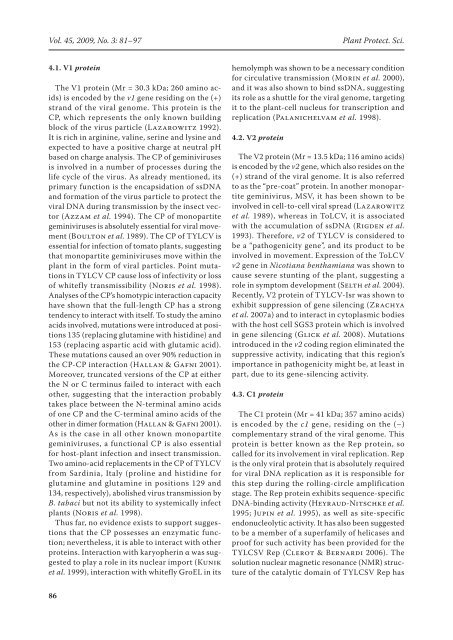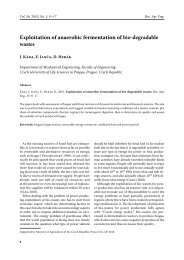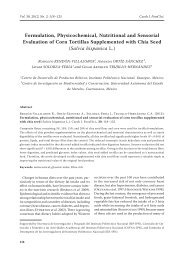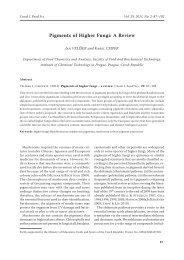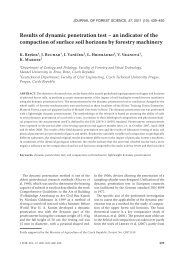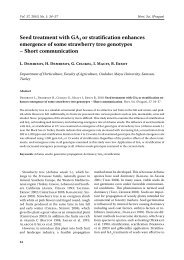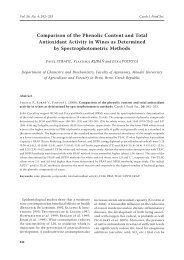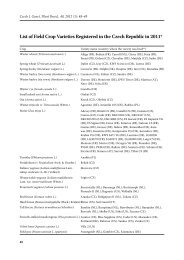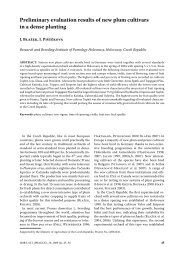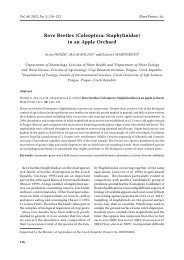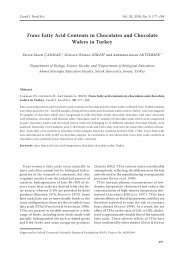The Viral Etiology of Tomato Yellow Leaf Curl Disease – A Review
The Viral Etiology of Tomato Yellow Leaf Curl Disease – A Review
The Viral Etiology of Tomato Yellow Leaf Curl Disease – A Review
You also want an ePaper? Increase the reach of your titles
YUMPU automatically turns print PDFs into web optimized ePapers that Google loves.
Vol. 45, 2009, No. 3: 81<strong>–</strong>97 Plant Protect. Sci.<br />
4.1. V1 protein<br />
<strong>The</strong> V1 protein (Mr = 30.3 kDa; 260 amino acids)<br />
is encoded by the v1 gene residing on the (+)<br />
strand <strong>of</strong> the viral genome. This protein is the<br />
CP, which represents the only known building<br />
block <strong>of</strong> the virus particle (Lazarowitz 1992).<br />
It is rich in arginine, valine, serine and lysine and<br />
expected to have a positive charge at neutral pH<br />
based on charge analysis. <strong>The</strong> CP <strong>of</strong> geminiviruses<br />
is involved in a number <strong>of</strong> processes during the<br />
life cycle <strong>of</strong> the virus. As already mentioned, its<br />
primary function is the encapsidation <strong>of</strong> ssDNA<br />
and formation <strong>of</strong> the virus particle to protect the<br />
viral DNA during transmission by the insect vector<br />
(Azzam et al. 1994). <strong>The</strong> CP <strong>of</strong> monopartite<br />
geminiviruses is absolutely essential for viral movement<br />
(Boulton et al. 1989). <strong>The</strong> CP <strong>of</strong> TYLCV is<br />
essential for infection <strong>of</strong> tomato plants, suggesting<br />
that monopartite geminiviruses move within the<br />
plant in the form <strong>of</strong> viral particles. Point mutations<br />
in TYLCV CP cause loss <strong>of</strong> infectivity or loss<br />
<strong>of</strong> whitefly transmissibility (Noris et al. 1998).<br />
Analyses <strong>of</strong> the CP’s homotypic interaction capacity<br />
have shown that the full-length CP has a strong<br />
tendency to interact with itself. To study the amino<br />
acids involved, mutations were introduced at positions<br />
135 (replacing glutamine with histidine) and<br />
153 (replacing aspartic acid with glutamic acid).<br />
<strong>The</strong>se mutations caused an over 90% reduction in<br />
the CP-CP interaction (Hallan & Gafni 2001).<br />
Moreover, truncated versions <strong>of</strong> the CP at either<br />
the N or C terminus failed to interact with each<br />
other, suggesting that the interaction probably<br />
takes place between the N-terminal amino acids<br />
<strong>of</strong> one CP and the C-terminal amino acids <strong>of</strong> the<br />
other in dimer formation (Hallan & Gafni 2001).<br />
As is the case in all other known monopartite<br />
geminiviruses, a functional CP is also essential<br />
for host-plant infection and insect transmission.<br />
Two amino-acid replacements in the CP <strong>of</strong> TYLCV<br />
from Sardinia, Italy (proline and histidine for<br />
glutamine and glutamine in positions 129 and<br />
134, respectively), abolished virus transmission by<br />
B. tabaci but not its ability to systemically infect<br />
plants (Noris et al. 1998).<br />
Thus far, no evidence exists to support suggestions<br />
that the CP possesses an enzymatic function;<br />
nevertheless, it is able to interact with other<br />
proteins. Interaction with karyopherin α was suggested<br />
to play a role in its nuclear import (Kunik<br />
et al. 1999), interaction with whitefly GroEL in its<br />
86<br />
hemolymph was shown to be a necessary condition<br />
for circulative transmission (Morin et al. 2000),<br />
and it was also shown to bind ssDNA, suggesting<br />
its role as a shuttle for the viral genome, targeting<br />
it to the plant-cell nucleus for transcription and<br />
replication (Palanichelvam et al. 1998).<br />
4.2. V2 protein<br />
<strong>The</strong> V2 protein (Mr = 13.5 kDa; 116 amino acids)<br />
is encoded by the v2 gene, which also resides on the<br />
(+) strand <strong>of</strong> the viral genome. It is also referred<br />
to as the “pre-coat” protein. In another monopartite<br />
geminivirus, MSV, it has been shown to be<br />
involved in cell-to-cell viral spread (Lazarowitz<br />
et al. 1989), whereas in ToLCV, it is associated<br />
with the accumulation <strong>of</strong> ssDNA (Rigden et al.<br />
1993). <strong>The</strong>refore, v2 <strong>of</strong> TYLCV is considered to<br />
be a “pathogenicity gene”, and its product to be<br />
involved in movement. Expression <strong>of</strong> the ToLCV<br />
v2 gene in Nicotiana benthamiana was shown to<br />
cause severe stunting <strong>of</strong> the plant, suggesting a<br />
role in symptom development (Selth et al. 2004).<br />
Recently, V2 protein <strong>of</strong> TYLCV-Isr was shown to<br />
exhibit suppression <strong>of</strong> gene silencing (Zrachya<br />
et al. 2007a) and to interact in cytoplasmic bodies<br />
with the host cell SGS3 protein which is involved<br />
in gene silencing (Glick et al. 2008). Mutations<br />
introduced in the v2 coding region eliminated the<br />
suppressive activity, indicating that this region’s<br />
importance in pathogenicity might be, at least in<br />
part, due to its gene-silencing activity.<br />
4.3. C1 protein<br />
<strong>The</strong> C1 protein (Mr = 41 kDa; 357 amino acids)<br />
is encoded by the c1 gene, residing on the (<strong>–</strong>)<br />
complementary strand <strong>of</strong> the viral genome. This<br />
protein is better known as the Rep protein, so<br />
called for its involvement in viral replication. Rep<br />
is the only viral protein that is absolutely required<br />
for viral DNA replication as it is responsible for<br />
this step during the rolling-circle amplification<br />
stage. <strong>The</strong> Rep protein exhibits sequence-specific<br />
DNA-binding activity (Heyraud-Nitschke et al.<br />
1995; Jupin et al. 1995), as well as site-specific<br />
endonucleolytic activity. It has also been suggested<br />
to be a member <strong>of</strong> a superfamily <strong>of</strong> helicases and<br />
pro<strong>of</strong> for such activity has been provided for the<br />
TYLCSV Rep (Clerot & Bernardi 2006). <strong>The</strong><br />
solution nuclear magnetic resonance (NMR) structure<br />
<strong>of</strong> the catalytic domain <strong>of</strong> TYLCSV Rep has


